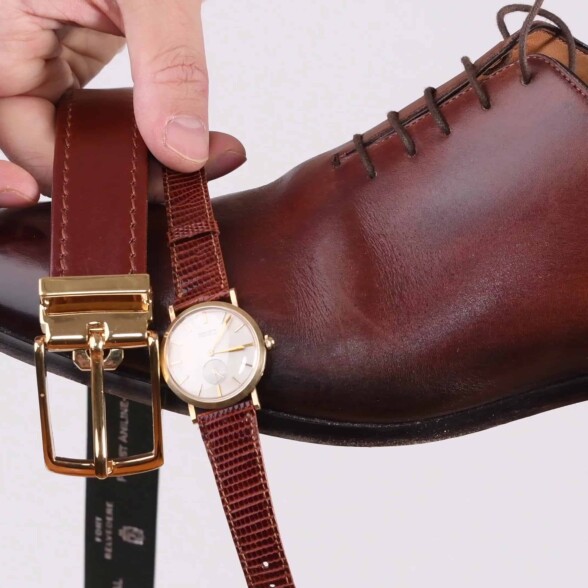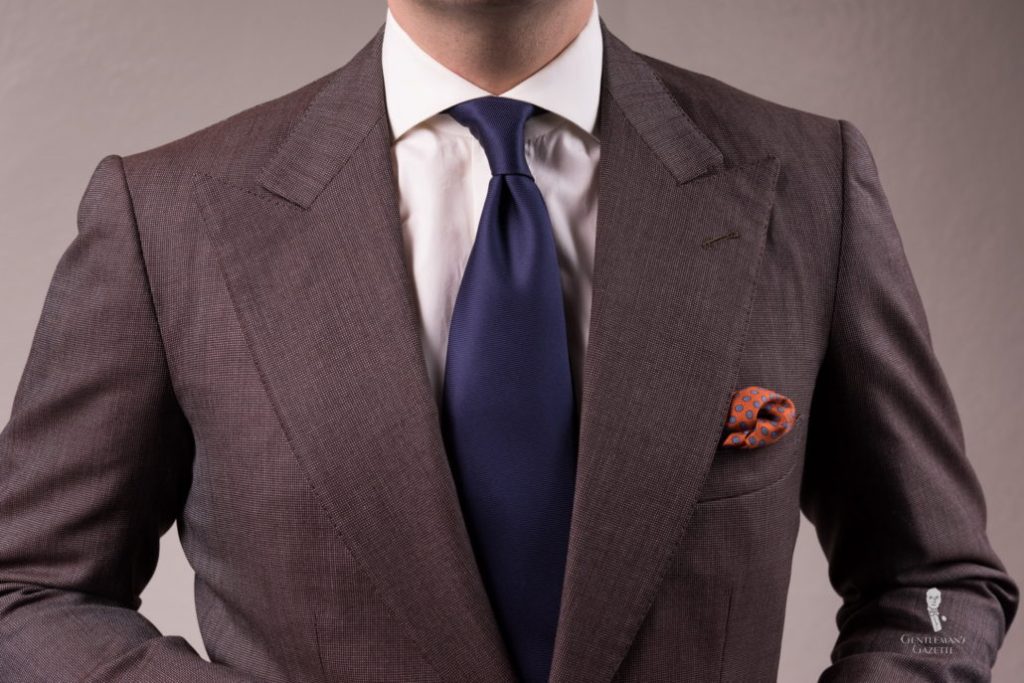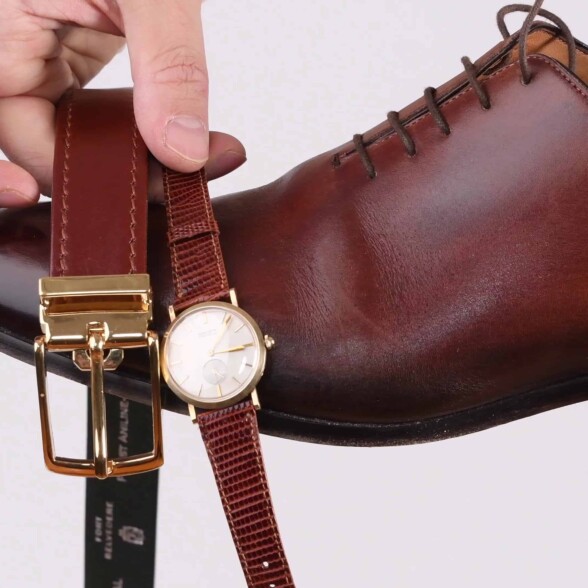In the ever-evolving world of menswear, the rules surrounding the use of brown and black shoes have shifted dramatically. Gone are the days when brown shoes were deemed inappropriate for town or evening wear. Today, they have become a staple in any fashionable man’s wardrobe, capable of creating impeccable outfits for all occasions. This transformation can be traced back to the 1930s, when Edward, the Prince of Wales, broke the mold by embracing brown shoes. While the rules have relaxed considerably, it is essential to exercise caution when pairing brown shoes with black pants. However, for the most part, brown shoes are incredibly versatile, complementing a wide range of colors and fabrics. That said, certain levels of formality, such as white-collar environments or formal dress codes, still demand the classic elegance of black shoes. So, whether you’re opting for a business or casual suit, our expert tips will guide you on how to flawlessly pair your brown shoes to make a fashion statement without compromising on style and appropriateness. After all, while brown shoes have undoubtedly risen in popularity, black shoes remain the go-to choice for those crucial formal occasions and black suits.
The Evolution of Menswear Rules
Throughout history, menswear rules and fashion standards have gone through significant changes. What was once considered a strict and unwavering set of guidelines has evolved into a more flexible and accepting approach. This article will delve into the historical perspective of menswear rules, explore the modern acceptance of brown shoes, discuss the incorporation of brown shoes into one’s wardrobe, examine the formality of brown shoes, provide guidelines for wearing brown shoes with different types of suits, and offer expert tips for pairing brown shoes with suits. We will also emphasize the continued importance of black shoes for formal occasions.
Historical Perspective
Black shoes as the norm for formal occasions
In the past, black shoes were considered the standard and appropriate choice for formal occasions. This strict adherence to black shoes was widely followed and was a reflection of the society’s view on proper attire. Town and evening wear, especially in high-society events, required gentlemen to don elegant and polished black shoes. It was perceived as a sign of sophistication and adherence to traditional fashion norms.
The influence of Edward the Prince of Wales
However, the menswear landscape took a significant turn in the 1930s when Edward the Prince of Wales, later King Edward VIII, introduced a more relaxed approach to fashion. Edward was known for his rebellious spirit and unique sense of style, often opting for brown shoes instead of the traditional black ones. This influential figure set a new trend that gradually spread throughout society, challenging the long-standing rule of black shoes for all formal occasions.

Modern Acceptance of Brown Shoes
Relaxation of menswear rules
Since Edward the Prince of Wales popularized the use of brown shoes, menswear rules have become more relaxed. Today, the rigid guidelines surrounding footwear have given way to a more inclusive and individualistic approach. The perception of brown shoes as being too casual or inappropriate for formal settings has shifted, allowing men to embrace them as a stylish and versatile option for any occasion.
Brown shoes accepted in all settings
Gone are the days when brown shoes were limited to casual or country attire. In the modern fashion landscape, brown shoes are widely accepted in all settings, including professional and formal environments. Whether it’s a business meeting or a wedding reception, one can confidently wear a pair of well-maintained and tastefully chosen brown shoes to make a fashion statement without compromising style or elegance.
Incorporating Brown Shoes into Wardrobe
Creating exemplary outfits
Brown shoes and boots can be seamlessly incorporated into any wardrobe, offering endless possibilities for creating exemplary outfits. By pairing brown footwear with the right clothing pieces and accessories, one can effortlessly elevate their style game. From tailored suits to denim jeans, the versatility of brown shoes knows no bounds.
Pairing brown shoes with different colors and fabrics
When it comes to pairing brown shoes with different colors and fabrics, the key is to consider the overall color scheme and balance of the outfit. Brown shoes generally pair well with a variety of colors, such as navy blue, grey, beige, and earth tones. In terms of fabrics, the richness and warmth of brown footwear complement textiles like tweed, corduroy, and flannel. Experimenting with different combinations can lead to unique and fashionable ensembles.
Caution when pairing with black pants
While brown shoes can be worn with various colors and fabrics, caution should be exercised when pairing them with black pants. The stark contrast between brown shoes and black pants can often create a visual imbalance and clash. Instead, consider opting for trousers in shades of grey, blue, or brown for a harmonious and well-coordinated look.
Consideration of shoe and pant styles
When incorporating brown shoes into one’s wardrobe, it’s important to consider the style of both the shoes and the pants. A sleek and streamlined pair of brown Oxfords or brogues can elevate the formality of an outfit, making it suitable for professional or dressier occasions. On the other hand, more casual shoe styles like loafers or desert boots can be effortlessly paired with chinos, jeans, or more relaxed suiting options for a laid-back yet stylish ensemble.

Formality and Brown Shoes
Avoiding brown shoes in higher levels of formality
While brown shoes have gained widespread acceptance, it is important to exercise caution when it comes to higher levels of formality. In white-collar environments or events with strict dress codes, sticking with traditional black shoes is still the safest and most appropriate choice. These formal settings often prioritize tradition and conservative fashion choices, making it essential to adhere to the established norms surrounding footwear.
White-collar environments and formal dress codes
In white-collar environments, such as corporate offices or legal professions, adherence to formal dress codes is crucial. Black shoes are still viewed as the standard and expected choice, aligning with the traditional and conservative nature of these workspaces. When professionalism and conformity are valued, it’s best to defer to the established guidelines and opt for black shoes.
Guidelines for Wearing Brown Shoes
Business suits
When it comes to wearing brown shoes with business suits, there are a few guidelines to keep in mind. Firstly, choose a shade of brown that complements the suit color. Rich, chocolate browns work well with navy or charcoal suits, while lighter or tan browns pair nicely with lighter shades of grey. Additionally, opt for sleek and polished shoe styles, such as Oxfords or brogues, to maintain a level of formality. Lastly, ensure that the overall outfit remains balanced and cohesive by coordinating accessories, such as belts or briefcases, with the chosen shade of brown.
Casual suits
While casual suits offer more flexibility in terms of styling, it’s still important to strike a balance between relaxed and formal. Brown shoes can be the perfect complement to a casual suit, adding a touch of elegance and sophistication. Pairing a light brown suit with tan or suede brown shoes creates a cohesive and stylish ensemble. However, it’s important to consider the occasion and context when choosing to wear brown shoes with a casual suit, ensuring that it aligns with the event’s dress code or the desired level of formality.

Expert Tips for Pairing Brown Shoes with Suits
To truly master the art of pairing brown shoes with suits, here are a few expert tips to keep in mind:
-
Matching belt and shoes: When wearing brown shoes, opt for a belt in a similar shade to maintain a harmonious and coordinated look.
-
Socks and shoe color: Choose a pair of socks that complements either the suit or the shoes. This allows for a balanced ensemble without creating distractions or visual disruptions.
-
Avoid excessively casual styles: While brown shoes are versatile, refrain from pairing them with extremely casual suit styles. Stick to tailored options and avoid sneakers or heavily distressed suit jackets.
-
Experiment with textures: Consider incorporating textured fabrics, such as tweed or corduroy, into your suit choices, as they pair exceptionally well with brown shoes. The contrasting textures add depth and visual interest to the outfit.
Remember, mastering the art of pairing brown shoes with suits requires experimentation and a keen eye for balance and coordination. By following these expert tips and guidelines, you’ll be well on your way to creating stylish and sophisticated ensembles.
The Continued Importance of Black Shoes
While brown shoes have gained immense popularity and acceptance, it’s important to understand that black shoes still hold a special place in the world of formal attire.
Best choice for formal occasions
For truly formal occasions, black shoes remain the best and most appropriate choice. Whether it’s a black-tie event or a formal business gathering, the elegance and timelessness of black shoes cannot be surpassed. Black shoes project a sense of seriousness and formality that may be expected in these settings, ensuring that one’s attire aligns with the established norms and etiquette.
Black suits
Additionally, black suits continue to play a significant role in formal fashion. When wearing a black suit, choosing black shoes maintains a complete and cohesive look. The monochromatic color scheme exudes elegance and sophistication, creating a powerful and polished ensemble. While brown shoes have their place in the fashion world, they should not replace the significance and impact of black shoes, particularly when it comes to formal occasions.
In conclusion, the evolution of menswear rules has brought about a newfound acceptance and appreciation for brown shoes. From its historical association with being a casual choice to its current prominence in various settings, brown shoes have proven themselves to be versatile and stylish. By following the guidelines for incorporating brown shoes into one’s wardrobe, understanding formality, and exploring expert tips, men can confidently embrace this fashion trend while respecting the continued importance of black shoes for formal occasions. So go ahead, experiment with different colors, fabrics, and styles, and elevate your fashion game with the timeless and ever-evolving world of menswear.

